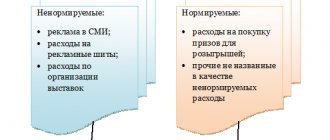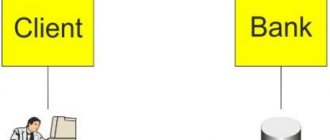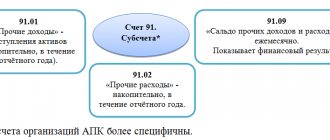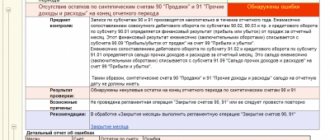How does the IP think?
Why should I keep any records, I don’t have to do it. Yes, I keep KUDIR on the simplified tax system, but why keep records on UTII if the tax is still not on real income? What's the result? But in the end, sooner or later there comes a time when separated information is required. The simplest example is that you need to divide your insurance premiums to reduce taxes on them. And without separate accounting data, you will not be able to do this correctly. To be honest, I don’t understand entrepreneurs who don’t keep any records at all. Even if you are on UTII and are not required to maintain KUDIR, you still need to record income/expenses for yourself.
Period frame for proportion
According to the latest position of the Ministry of Finance, when calculating the proportion, income within the framework of UTII and for the simplified tax system with the object “income minus expenses” must be taken in an increasing amount from the beginning of the year. The tax period is not taken as a basis here, since for UTII it is a quarter, and for the “simplified” tax period it is a year.
Note that the one-year principle contradicts previously published letters from the Ministry of Finance. In them, officials argued that costs must be determined monthly, based on the amount of revenue and expenses for the month. Now the practice has been established for the annual period of final calculation of expenses on a cumulative basis.
What are the consequences of not having separate accounting?
There are the following risks:
- You may incorrectly calculate the amount of taxes to be paid, further consequences depend on which direction - overstatement or understatement - the distortion occurred;
- When checking, tax officials may consider that your separate accounting is incorrect or not maintained at all, and charge additional taxes.
The requirements that it is necessary to keep separate records are in the Tax Code of the Russian Federation - this is clause 8 of Art. 346.18 and paragraph 7 of Art. 346.26. Of course, there are no specific methods in the Tax Code of the Russian Federation. In theory, you should develop them yourself and formalize them in the form of an accounting policy. By the way, in the next article we will try to talk specifically about the accounting policy for individual entrepreneurs and give an example of it.
Income for proportion
It is generally accepted that the right decision is to choose the proportion of revenue for each area of activity as income for calculating the proportion. Side income (Article 251 of the Tax Code of the Russian Federation, etc.) is not taken into account when determining it.
It is correct from a legal point of view to apply this approach to income from the sale of property that is no longer in use and other similar types of income.
Let us recall that the revenue indicator should be determined in this way:
- under the simplified tax system, the cash method is used;
- with UTII, the basis is accounting information, although the cash method is also not prohibited.
In addition, let us add that there is another tax regime - the unified agricultural tax, which also provides for the cash method when calculating the amount of income. Based on the foregoing, when combining this special regime and UTII, you can use the approach described above to determine the proportion.
How to divide income
Let's start with the fact that simplified income is reflected in KUDIR; no document is provided for imputed income. But since you still need to reflect them, you can develop a special accounting register, or, more simply put, a table where you will keep separate records of income. For example, it can be done like this:
| Tax register for separate accounting of income of individual entrepreneur Ivanov I.I. for 2021 | |||
| Income from UTII | Income from the simplified tax system | ||
| Document number and date | Amount of income, rub. | Document number and date | Amount of income, rub. |
| January | |||
| No. 1 from 01/16/2019 | 10 000 | No. 3 from 01/18/2019 | 20 000 |
| No. 2 from 01/17/2019 | 15 000 | No. 4 from 01/20/2019 | 25 000 |
| … | … | … | … |
| Total for January | 25 000 | 45 000 | |
| February | |||
| … | … | … | … |
| Total for February | … | … | |
| March | |||
| … | … | … | … |
| Total for March | … | … | |
| Just in 1 quarter | 25 000 | 45 000 | |
In theory, income is divided between special regimes based on payment documents. But there may be different situations:
- When the proceeds according to the simplified tax system go to the current account, and according to UTII - to the cash desk. Everything is simple here: the results from bank statements go into “simplified” income, the results from the cash book go into “imputed” income;
- When all proceeds go to the cash register. Here you can divide the revenue by breaking it into different sections of the cash register system. Then in your Z-report the results will be formed by department, and you will be able to divide income between accounting modes;
- When all proceeds go to the current account. In this case, you can enter different numbering of invoices issued for payment to clients. For example, business accounts on the simplified tax system are numbered as 1/U, 2/U, etc., and according to imputation - 1/E, 2/E, etc. When paying, the client will indicate the invoice number you issued on the payment slip, and you will be able to divide the income based on this. You can read about how to issue an invoice for payment here;
- When BSO or sales receipts/receipts are issued for UTII. Then the imputation income will be confirmed by these documents; when combining modes, it is better to always write them out, and not just at the buyer’s request. Simplified income in this case will be confirmed either by cash documents or bank statements - it depends on how the revenue is received.
Based on the division of income from payment documents described above, you enter the amounts of revenue related to a particular mode into a register developed for accounting. You don’t have to report income under the simplified tax system; you already do this in KUDIR, so it will be enough to transfer the totals to the register.
What rules should you follow when maintaining separate cost accounting?
Separate accounting of income is not difficult - this is proven by everything described above. Much more difficult considering the costs. Especially if you use the simplified tax system with the object “income minus expenses” with UTII. Let's consider this combination in more detail.
The main rule of the Tax Code is this: when combining the above tax regimes, existing expenses must be distributed in proportion to revenues. True, in reality everything is not so simple. The following controversial points arise:
- What income is implied when calculating shares - all or just revenue?
- What period should be considered to determine the size of the proportion?
How to divide expenses
Dividing expenses is much more complicated. Why?
Yes, because when combining modes, there are expenses that relate specifically to a business on UTII or specifically to a business on the simplified tax system, and there are those that relate to both at the same time. How to distribute these “simultaneous” expenses?
I’ll say right away that it’s easier for those who have simplified income.
They can reduce the tax only on insurance premiums and other related payments in the same series and the trading tax. Insurance premiums can be deducted from UTII. Accordingly, here we are talking, in fact, only about the division of these same contributions. But if the simplification is calculated from the difference between income and expenses, you will have to seriously consider separately accounting for other expenses.
What will you have to share besides insurance premiums?
These could be rental payments for premises that are used both there and there, bills for electricity and other utilities, payment for accounting services, etc.
How to divide them?
Expenses are divided between modes in proportion to income. That is: we take all the income, calculate what share of it comes from business income on a simplified basis, the rest of the share comes from revenue from a business on imputation. Then we multiply the expenses to be distributed by the interest received - and here we have the divided amounts of expenses.
What income should I take?
For calculations, we take actual income. For the simplified tax system they are filled out in KUDIR, for UTII - in the tax register, an example of which we gave above.
For what period should income be taken?
There is one catch when distributing expenses: on the simplified tax system, indicators are considered an accrual total, on UTII we report every quarter. The solution is this: we distribute the total expenses based on the results of each month, and then sum up the results.
It is also advisable to keep records of expenses and their distribution in a special register. You can, for example, like this:
| Tax register of separate accounting of expenses of individual entrepreneur Ivanov I.I. for 2021 | |||||
| Amount of total expenses to be distributed | Shares of income by type of activity, % | Amounts of expenses attributed to types of activities, rub. | |||
| Document number and date | Amount of expense, rub. | UTII | simplified tax system | UTII | simplified tax system |
| January | |||||
| No. 7 from 01/22/2019 | 20 000 | 35,72 | 64,28 | 7 144 | 12 856 |
| … | … | … | … | … | … |
| Total for January | 20 000 | 7 144 | 12 856 | ||
Let's immediately give an example of the calculation. In the example of a tax register for accounting for income, in January we had 25 thousand rubles in revenue from a business on UTII, and 45 thousand rubles from a business on the simplified tax system. In total, 70 thousand rubles were received in January. Let's say in January we paid 20 thousand rubles for rent. We need to divide these expenses, since the premises are used in both places.
What are we doing?
We calculate the shares of income: for UTII = 25/70*100% = 35.72%; for simplified tax system = 45/70*100% = 64.28%. Now we distribute the total expenses: 20,000 * 25.72% = 7,144 rubles are spent on UTII, 20,000 * 64.28% = 12,856 rubles are spent on the simplified tax system.
I will also add that you can carry out separate accounting of income and expenses together in one register, and divide expenses in it. Since there are no unified forms for this, you can develop the register tables yourself, that is, make them the way that is convenient for you. In the article we simply gave an example of how this can be.
Why is separate accounting of income and expenses necessary?
Paragraph 8 of Article 346.18 of the Tax Code requires that a payer operating under both taxation regimes - the simplified tax system and the UTII - maintain separate records of income and expenses within each. If this responsibility is ignored, it will become impossible to correctly determine:
- object of taxation “imputed”;
- tax base according to a simplified system.
A competent approach to organizing separate accounting for the simplified tax system and UTII will give the taxpayer the opportunity to easily monitor the amount of his income, which was received within the framework of the “simplified tax system”. Why is it important? The fact is that if the business turnover is considerable, you need to check every quarter to see if the income exceeds the limits established for “simplified”. Otherwise, expect a forced transfer of your case to the general tax regime with all the ensuing consequences (clause 4.1 of Article 346.13 of the Tax Code of the Russian Federation). Since tax reporting must be submitted based on the results of the past year, you will have to pay additional penalties and taxes for the quarter in which you exceeded the simplified tax system standards.
First of all, it is necessary to properly establish separate accounting of payments to employees involved in the business. Thus, insurance premiums will be distributed according to special regimes. The need for this arises because:
- on the simplified tax system with the object “income” and UTII, the amounts of insurance contributions are directed to reduce the tax itself
- in a “simplified” way with the object “income minus expenses”, existing insurance premiums go into expenses.
The taxpayer should always keep separate records of his subordinate employees, dividing them clearly among themselves by type of activity.
Insurance premiums when combining modes
For special regimes, no one has canceled the mandatory requirements for contributions to the insurance fund for each company employee, and for entrepreneurs - also for themselves.
Let's consider the distinctive features of accounting for insurance deductions:
- On the “UTII + simplified tax system “Income” system, the tax base is reduced by the amount of insurance contributions;
- If “STS “Income-Expenses” is selected, insurance contributions are included in the list of expenses;
- Insurance deductions for each area of activity are accounted for separately.
When maintaining accounting registers, you need to designate, in addition to accounts 69 and 70, subaccounts , to which insurance payments for areas of activity will subsequently be allocated. To do this, you will have to divide all the company’s employees into three groups:
– those engaged in work, the income from which is taxed under UTII;
– performing work, the income from which is taxed according to the simplified tax system;
– working in an area where profits are subject to both types of taxes.
For the third case, the following methods for accounting for insurance contributions :
- Insurance payments are divided in proportion to the shares of cash receipts within the framework of “imputation” or “simplification”. Under the “UTII + simplified tax system “Income” mode, insurance payments are distributed in the same way as total costs.
- Based on the division of insurance payments in proportion to the amount of profit; it should be carried out every month.
- Distribution commensurate with the share of payments. Income issued to employees is distributed in proportion to the amount of profit received from the area of activity, income from which is taxed under the simplified tax system or under UTII, in the total amount of funds paid to employees.
General rules for entrepreneurs (STS + UTII) for reducing the tax base through contributions :
- For the simplified tax system “Income minus expenses” . Expenses on insurance contributions for oneself and for employees are considered expenses when calculating the size of the tax base; they cannot be deducted from the tax itself.
- For the simplified tax system “Income”. Individual entrepreneurs are allowed to reduce taxes on total contributions for employees and for themselves, but not more than half the amount.
- For UTII. The costs of insurance deductions for oneself are borne by the entrepreneur and are not reimbursed. As for contributions to the Social Insurance Fund for employees, they reduce the tax, but by no more than 1/2 of its entire amount.
Distribution of amounts of paid insurance premiums
Quite rightly, there may be a need to distribute not all expenses if the company is on the simplified tax system (the object of income taxation), but only the amount of insurance premiums. After all, both “simplified” and “imposed” reduce the amount of tax by the amount of insurance contributions for compulsory pension insurance, compulsory social insurance in case of temporary disability and in connection with maternity, compulsory medical insurance, compulsory social insurance against accidents at work and occupational diseases , paid (within the calculated amounts) in a given tax (reporting) period, in accordance with the legislation of the Russian Federation (subclause 1, clause 3.1, article 346.21 and subclause 1, clause 2, article 346.32 of the Tax Code of the Russian Federation).
In this case, you must act similarly to the general procedure for distributing expenses, that is, distribute the amounts of contributions in proportion to the shares of income in the total amount of income received when applying these special tax regimes (letter of the Ministry of Finance of Russia dated 02/09/2018 No. 03-11-11/7882, dated 08/11/2017 No. 03-11-11/51743, dated 08/10/2017 No. 03-11-11/51316, etc.). And in this case, with regard to the calculation methodology, it will not matter whether the entrepreneur has employees or whether he pays contributions only for himself.
With PSN the situation is somewhat different. Letters from the Ministry of Finance of Russia dated November 16, 2016 No. 03-11-12/67076, dated April 7, 2016 No. 03-11-11/19849 reasonably state that the possibility of reducing the amount of tax when applying a patent tax system on the amount of insurance premiums is not provided for by law. In this regard, an entrepreneur who combines the simplified taxation system and the patent taxation system has the right to reduce the amount of tax paid in connection with the use of the simplified taxation system by the amount of insurance premiums paid.
What should be reflected in the accounting policy?
The whole point of separate accounting of cash receipts is to record the amount of profit in all areas of core activity separately . Difficulties arise in adjusting accounting records, mainly due to the large amount of data. If, when using UTII and the simplified tax system “Income” together, it is at least clearly visible which information relates to the simplified tax system and which to the “imputation”, then when choosing a “simplified” system according to the “Income – Expenses” system, you have to separately take into account three categories of income and costs. The task is simplified by maintaining a single register permitted by law.
As required by law and simply for convenience, additional subaccounts are introduced into the chart of accounts to include profits and expenses from both types of activities , divided according to the principle of taxation. Separate sub-accounts are also useful for some transactions that are not related to tax regimes.
The section “Income subject to UTII” includes profits from the sale of goods, services, performance of work , as well as all other income falling under activities, the profit from which is subject to UTII. Other income, as specified by the Ministry of Finance, means:
- receipts from fulfilling special requirements of the counterparty, for example, monetary incentives from him (in this case, income was received within the framework of “imputation”);
- surpluses found during audits ;
- penalties received from debtors .
It happens that it is decided to conduct wholesale trade on the simplified tax system, and retail trade on UTII, and in this case the income listed above can be counted as profit subject to “imputation”. In this regard, there is another point highlighted by the Ministry of Finance, regarding “imputation” and SST and not having anything to do with the combination “STS + UTII”: if such bonuses cannot be unambiguously correlated with the type of activity, then distribution is not allowed.
Separate accounting of the simplified tax system and UTII for individual entrepreneurs
Combining such regimes for individual entrepreneurs is even more difficult, since he must pay insurance premiums for employees, as well as transfer contributions to the Pension Fund and the Compulsory Medical Insurance Fund for himself. If an individual entrepreneur does not have employees, then he can deduct insurance premiums from advance payments using imputation or simplification.
If an individual entrepreneur has employees, then the tax reduction looks like this:
- UTII: insurance premiums for employees in the amount of no more than 50% of the tax amount are taken into account for reduction;
- STS “Income”: you can reduce the tax on contributions for employees and for yourself up to 50%;
- STS “Income-expenses”: insurance premiums for yourself and for employees are included in expenses.
Important! For errors in accounting, a fine of 5,000 rubles is provided (FZ-77, Article 15.11 of the Administrative Code).
How to divide general business expenses?
In order to correctly distribute income among different types of tax regimes applied, you need to adhere to the following algorithm:
- calculate the amount of simplified and imputed income separately within one period (it is better to do the calculation quarterly, although tax authorities recommend doing this monthly);
- calculate the total amount of income within one period (both revenue and non-operating income);
- determine the ratio of income from simplification and total income;
- determine the ratio of income from imputation and the total amount of income;
The calculated ratios must be applied for the purpose of allocating general business costs, which are of a general nature and cannot be associated with any specific type of activity. Thus, in reducing the tax base for the simplified tax system, that part of general business expenses that is obtained using the given proportion will be taken into account.
Since expenses do not take part in the calculation of UTII, the calculated coefficient is important only for determining the base for the simplified tax system. The rest of the general business expenses, not included in the simplified base, are not taken into account in the future.






